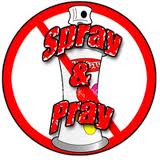 In the weeks leading up to the government shutdown, I heard some rumblings via the news media that Senator Ted Cruz and those aligned with him were dragging things out in Congress to maximize their online and direct mail fundraising efforts. To be honest, I didn’t give much thought to those accusations. They sounded like sour grapes and something partisan opponents would say in the heat of the moment. And then . . . when the government actually shut down, I started receiving a flood of email from the Democratic Congressional Campaign Committee (DCCC). This is when my fundraising spidey-sense started to tingle, and I started paying attention because there must be lessons to be learned for non-profit organizations somewhere in this mess.
In the weeks leading up to the government shutdown, I heard some rumblings via the news media that Senator Ted Cruz and those aligned with him were dragging things out in Congress to maximize their online and direct mail fundraising efforts. To be honest, I didn’t give much thought to those accusations. They sounded like sour grapes and something partisan opponents would say in the heat of the moment. And then . . . when the government actually shut down, I started receiving a flood of email from the Democratic Congressional Campaign Committee (DCCC). This is when my fundraising spidey-sense started to tingle, and I started paying attention because there must be lessons to be learned for non-profit organizations somewhere in this mess.
Here is what the most recent DCCC fundraising email said:
Dear Erik —
Boehner’s Tea Party majority is teetering on the edge:
A new poll shows that Democrats are leading SEVENTEEN Republican Congressmen after the Tea Party-inspired shutdown. Guess how many seats we need to win back a Democratic Majority? 17.
Voters are done putting up with the extreme Tea Party antics that have paralyzed the government. We have to act quickly to press our advantage in these crucial races. Will you help us raise $500,000 immediately to take on vulnerable House Republicans?
Donate $3 IMMEDIATELY to the Democratic Majority Rapid Response Fund.
This shutdown could spell the end of the Tea Party controlled Republican Majority.
But if we want that to happen, we have to act now.
Thanks,
DCCC Rapid Reponse
I purposely omitted the hyperlinks and website addresses because my intention is to evaluate language and strategy and not raise money for the DCCC.
So, let’s strip out the partisanship and set aside our personal political feelings. Let’s avoid the temptation to point fingers. Let’s just look at the circumstances, strategies and verbiage in the letter from a “Just the facts, ma’am” perspective.
What do you see? What do you sense?
 Here is what I’m seeing:
Here is what I’m seeing:
- I see a misspelling in the signature block.
- I see a case for support spelled out in five simple sentences.
- I see emotionally charged words intended to poke and prod me into action (e.g. teetering, extreme, paralyzed, etc).
- I see a fundraising goal clearly articulated (e.g. $500,000).
- I see a specific ask (e.g. Donate $3.00 immediately).
- I sense the strategy here is to set a very low barrier to entry to entice first time donors. In other words, they poke me, I get upset, and the solution is as simple as just giving $3.00 to make things right again.
- I see an email with a small handful of carefully worded sentences fitting neatly on my computer screen. I don’t need to scroll down to continue reading.
- I see short easy to read sentences. The longest sentence was 16 words long.
There is so much that you can learn if you just keep your eyes, ears and mind open. Professional fundraisers cram your mailbox and email inbox full of examples every day. Are you paying attention? Because with a little discipline you can teach yourself a lot in a short period of time.
Let’s circle back to the question I pose in the headline of this blog post:
Did fundraising cause the recent government shutdown?
I think a case can be made for the answer to this question being “YES”.
There is so much noise being made in our political arena on a daily basis that many people tune things out. I know that I am as guilty as others in this regard. So, when you have fundraising goals to hit, then your case for support needs to be very big and noisy in order to get people’s attention.
I believe the lesson to be learned here for non-profit organizations is that your case for support is powerful. It is the engine at the center of your resource development plan. It is the jet fuel for all of your fundraising appeals regardless of whether it is a direct mail appeal, email, social media, telephone solicitation, face-to-face pledge drive or special event.
 When crafting your case for support, this is what our friends in the political fundraising world seem to be telling their non-profit cousins:
When crafting your case for support, this is what our friends in the political fundraising world seem to be telling their non-profit cousins:
- Make it emotional
- Focus on an issue that people care about
- Choose an issue that donors and the media will talk about and magnify
- Wrap marketing efforts around your fundraising efforts
- Where possible, infuse advocacy into the appeal
For those of you who are skeptical and find yourself thinking at the end of this blog post that non-profit organizations can’t “manufacture” a crisis and weave it into a case for support like politicians, then let me suggest that you open your mind a little more.
I cannot tell you how many agencies I’ve seen neglect their buildings by minimally investing in maintenance and upkeep. In the final analysis, aren’t those agencies just slowly creating a powerful capital campaign case for support for down the road? Maybe it is purposeful and maybe it isn’t, but the fact that it is a manufactured crisis cannot be denied.
There are plenty of needs and gaps in our communities around which non-profit organizations can build a powerful case for support. We don’t need to manufacture crisis to raise money like our political counterparts, but it does happen more often than you think.
So, what are you waiting for?
It is the fourth quarter and year-end fundraising is one of the biggest shows on Earth. Start writing your case for support document today so you can transform it into an eloquent and powerful fundraising appeal in the next few weeks.
But whatever you do, please don’t “shutdown” your agency to make a buck or two. I suspect donors can only handle this strategy in small doses. 😉
And I am making a mental note to myself . . . perhaps, I need to stop tuning out politicians on a daily basis so they stop doing drastic things to get my attention. 😉 (Sorry, I just couldn’t help myself.)
Here’s to your health!
Erik Anderson
Founder & President, The Healthy Non-Profit LLC
www.thehealthynonprofit.com
erik@thehealthynonprofit.com
http://twitter.com/#!/eanderson847
http://www.facebook.com/eanderson847
http://www.linkedin.com/in/erikanderson847
 For those of you who are new to the DonorDreams blog, I’m going chapter by chapter through Lon Safko’s book, The Social Media Bible and applying his thoughts to the non-profit sector in a blog on Monday mornings. Of course, it is Tuesday morning (because Erik just returned from his five month engagement in Texas & New Mexico and he got confused).
For those of you who are new to the DonorDreams blog, I’m going chapter by chapter through Lon Safko’s book, The Social Media Bible and applying his thoughts to the non-profit sector in a blog on Monday mornings. Of course, it is Tuesday morning (because Erik just returned from his five month engagement in Texas & New Mexico and he got confused).

 I graduated from the University of Illinois Urbana-Champaign with my graduate degree in Urban Planning in 1994. In the summer immediately following graduation, I received my first fundraising appeal from the university. So, this story started almost 20 years ago, and it ended last night in an Applebee’s restaurant in Roswell, NM. In my opinion, there are lots and lots of little lessons throughout this story that every fundraiser should internalize.
I graduated from the University of Illinois Urbana-Champaign with my graduate degree in Urban Planning in 1994. In the summer immediately following graduation, I received my first fundraising appeal from the university. So, this story started almost 20 years ago, and it ended last night in an Applebee’s restaurant in Roswell, NM. In my opinion, there are lots and lots of little lessons throughout this story that every fundraiser should internalize. Almost 13 years later, The Chief danced his last dance at a football or basketball game.
Almost 13 years later, The Chief danced his last dance at a football or basketball game. I was having breakfast this week with a friend and fellow consultant and we were discussing resource development efforts, including events and grants. By now I’m sure you are well aware, I’m not a huge fan of organizations hosting multiple events. Events are expensive, labor intensive and don’t usually generate a lot of income.
I was having breakfast this week with a friend and fellow consultant and we were discussing resource development efforts, including events and grants. By now I’m sure you are well aware, I’m not a huge fan of organizations hosting multiple events. Events are expensive, labor intensive and don’t usually generate a lot of income. Grants, which are often 30% to 50% of an agency’s budget, more if they receive United Way funding, are one way. Yet, they too come with a cost. Most agencies get somewhere between 50% to 80% of the grants they submit. That means that the time spent on writing the 20% to 50% of the grants that don’t get funded is time lost. For the grants that are secured, there are reports to be written, dollars to be tracked, objectives to reach and programming to introduce. All of which is as it should be, and none of which is without cost.
Grants, which are often 30% to 50% of an agency’s budget, more if they receive United Way funding, are one way. Yet, they too come with a cost. Most agencies get somewhere between 50% to 80% of the grants they submit. That means that the time spent on writing the 20% to 50% of the grants that don’t get funded is time lost. For the grants that are secured, there are reports to be written, dollars to be tracked, objectives to reach and programming to introduce. All of which is as it should be, and none of which is without cost.
 The new normal has forced a lot of nonprofit leaders to rethink the way they do business. Crises, as unpleasant as they are to experience, allow for growth. I love Rahm Emanuel’s quote “Never let a good crisis go to waste.”
The new normal has forced a lot of nonprofit leaders to rethink the way they do business. Crises, as unpleasant as they are to experience, allow for growth. I love Rahm Emanuel’s quote “Never let a good crisis go to waste.” Let’s get those people together and brain storm: Where are we today? Where do we want to go? How can we get there?
Let’s get those people together and brain storm: Where are we today? Where do we want to go? How can we get there? In the weeks leading up to the government shutdown, I heard some rumblings via the news media that Senator Ted Cruz and those aligned with him were dragging things out in Congress to maximize their online and direct mail fundraising efforts. To be honest, I didn’t give much thought to those accusations. They sounded like sour grapes and something partisan opponents would say in the heat of the moment. And then . . . when the government actually shut down, I started receiving a flood of email from the Democratic Congressional Campaign Committee (DCCC). This is when my fundraising spidey-sense started to tingle, and I started paying attention because there must be lessons to be learned for non-profit organizations somewhere in this mess.
In the weeks leading up to the government shutdown, I heard some rumblings via the news media that Senator Ted Cruz and those aligned with him were dragging things out in Congress to maximize their online and direct mail fundraising efforts. To be honest, I didn’t give much thought to those accusations. They sounded like sour grapes and something partisan opponents would say in the heat of the moment. And then . . . when the government actually shut down, I started receiving a flood of email from the Democratic Congressional Campaign Committee (DCCC). This is when my fundraising spidey-sense started to tingle, and I started paying attention because there must be lessons to be learned for non-profit organizations somewhere in this mess. Here is what I’m seeing:
Here is what I’m seeing: When crafting your case for support, this is what our friends in the political fundraising world seem to be telling their non-profit cousins:
When crafting your case for support, this is what our friends in the political fundraising world seem to be telling their non-profit cousins: Recently, I’ve been doing a lot of what I consider “Nonprofit 101” trainings focused on board roles and responsibilities. After talking with board members about their fiduciary responsibilities, they often push back on their role in fundraising. I’m becoming really good at giving them the “sympathetic smile,” which communicates that I’m hearing their fear but not giving them permission to wash their hands of their role in resource development.
Recently, I’ve been doing a lot of what I consider “Nonprofit 101” trainings focused on board roles and responsibilities. After talking with board members about their fiduciary responsibilities, they often push back on their role in fundraising. I’m becoming really good at giving them the “sympathetic smile,” which communicates that I’m hearing their fear but not giving them permission to wash their hands of their role in resource development. After all, how scary can it be to “tell stories,” right?
After all, how scary can it be to “tell stories,” right? The concept of “spray and pray” in resource development is simply sending out many appeals (aka shotgun effect), and then waiting for (aka hoping and praying) that enough donors respond so that you can make your goal. “Spray and pray” doesn’t just refer to direct mail. Back in the day, I used it in annual campaigns where I asked fundraising volunteers to identify five people from their social network, sit down with them in-person, and ask for a pledge or contribution. If your fundraising program is still loaded with “spray and pray” strategies, then you’re probably struggling because those days are long since over.
The concept of “spray and pray” in resource development is simply sending out many appeals (aka shotgun effect), and then waiting for (aka hoping and praying) that enough donors respond so that you can make your goal. “Spray and pray” doesn’t just refer to direct mail. Back in the day, I used it in annual campaigns where I asked fundraising volunteers to identify five people from their social network, sit down with them in-person, and ask for a pledge or contribution. If your fundraising program is still loaded with “spray and pray” strategies, then you’re probably struggling because those days are long since over. think millions of other donors) would be:
think millions of other donors) would be:



